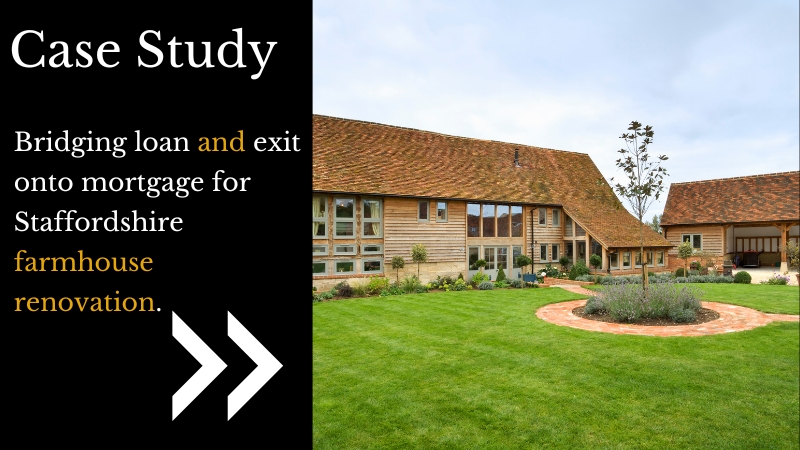Categories
Remortgaging After Bridging Finance | How it Works

Bridging loans give you the power to buy property quickly, opening opportunities that a standard mortgage simply cannot provide. But bridging solutions are short-term finance that are designed based on an exit strategy that typically sees them paid off within a year. How is that done?
We’re here at Clifton Private Finance to provide our customers with a smooth transition from bridging finance to a cost-effective low-rate mortgage. For a no-obligation call with an adviser, contact us today, and read on to learn more about how the process works.
Key Takeaways
- Remortgages form one of the three key exit strategies for bridging finance
- Remortgaging is used either to keep the property as a home, or to rent it out as a landlord
- Specialist advice and help is essential to get the best deals when remortgaging as a bridging finance exit
Bridging Finance Exit Strategies
Bridging finance is a very different type of funding solution to a mortgage. Rather than being repaid gradually over time, it is developed with an exit strategy that typically involves one of three options:
- Refinancing with alternative long-term finance, such as a mortgage.
- Selling the financed property for profit.
- Selling an existing property, such as the house you are moving from.
To understand more about bridging loans and their structure, it’s worth exploring our detailed Guide to Bridging Loans.
If you intend to keep the property, either to live in, or to rent out as a landlord, then remortgaging is the most applicable long-term finance available.
Not only does it provide you with the funding you need to repay the bridging finance, it also has four additional benefits:

Lowering interest
Once you have switched from bridging finance to a mortgage, you will immediately lower the level of interest that is being generated. While bridging finance is quick and efficient, it is a more costly option than a mortgage.

Improving financial security
A mortgage is a lower-risk loan. Once settled into the regular monthly repayments, you will enjoy greater peace of mind and financial stability.

Consolidating debt
At the point of moving from bridging finance to a mortgage, you will have the opportunity to fold in other debts. If the value of your property is sufficient, this may enable you to clear credit cards and overdrafts, or pay off other existing credit with this lower-interest alternative.

Releasing equity as cash
Your property value may have increased since the bridging finance was put in place. This may be because renovations or extensions have been done, or simply because the market value for your property has improved.
Remortgaging After Bridging to a Residential Mortgage
If you are living in the property, you will typically be looking for a residential repayment mortgage. This converts your bridging finance into a long-term (typically 15 to 25 years) repayment structure that will result in the property being yours in full at the end of the term.
Working with a broker will ensure that you obtain the best rates on your residential mortgage.
Remortgaging to an Interest-Only Mortgage as a Landlord or Property Investor
When looking to make the most from your property as a rental home, you may look for a suitable interest-only mortgage. This long-term mortgage options replaces any bridging finance with the lowest possible monthly payments, giving you the maximum profit through the rental yield on your property.
Our mortgage team will help you develop your property portfolio by converting your existing bridging finance into either a single buy-to-let mortgage that’s suitable for individual landlords, or by working on a full portfolio mortgage structure that enables you to leverage the equity in this and other properties for future expansion and investment.
With thorough understanding of the tax obligations and other responsibilities of both individual landlords and limited company setups, our advisors will be alongside throughout the process, minimising costs and interest rates, and maximising the level of return on your investment. A continued strategy that utilises bridging finance for short term property acquisition and renovation, folded into long-term portfolio mortgages once the properties meet more stringent mortgage conditions provides landlords with a sustainable business model based on growth in the UK property market.
The Difficulties of Remortgaging After Bridging Finance - And What You Can Do
For some lenders, the higher risk nature of bridging finance provides additional challenges when considering mortgages, both for residential and investment purposes.
Often, bridging finance has been used to facilitate renovations on properties that were previously considered uninhabitable.
These include:
- A requirement for complete property re-evaluation, including thorough survey and conveyancing.
- Property equity, which affects loan-to-value and potential additional deposits.
- A need for the property to have been in your possession for a minimum term, often six to twelve months.
- Regulations regarding responsible lending requiring complete affordability checks and stress testing.
- Complete business planning and rental yield forecasting when considering properties for let.
Working with an experienced mortgage broker, such as Clifton Private Finance, makes the process as smooth as possible.
With decades of expertise in the mortgage market, we can match you to a mortgage provider who will be happy to consider your move from bridging finance to a more stable long-term mortgage, working through any of the potential pitfalls to complete the process with minimal fuss.
Remortgaging When Equity is Low
It is always the hope that when your bridging finance term is coming to an end, that the equity in the property is substantial enough that a suitable mortgage will completely cover the exit requirements.
Unfortunately, there are a select few cases where this doesn’t occur:
- Regional property market has suffered and property value has dropped
- Planned renovations were not completed in time
- Renovations did not add the value expected
Delays in exiting your bridging finance will incur additional interest and could potentially compound the problem. Thankfully, Clifton Private Finance are here to help. We can work with you to consider options such as:
- Renegotiating or refinancing your bridging finance
- Securing additional funds for the deposit to meet the mortgage requirements
- Looking to alternative exit strategies, such as property sale
- Searching the full UK marketplace of mortgage lenders to find more understanding lenders willing to consider your circumstances
Remortgaging When Property Ownership is Short
For those looking to turn a profit as soon as possible, moving their properties from bridging finance to a suitable mortgage to keep costs low, we can help.
Options include:
- Finding alternative lenders willing to offer mortgages despite the short ownership length
- Negotiating with bridging finance providers to consider remortgage with the same lender
- Looking into alternative solutions to keep costs low while bridging remains in place
Mortgages when Affordability and Credit Presents a Problem
Affordability and credit history can often affect planned mortgage-based exit strategies. In some cases, the bridging finance itself affects affordability, perversely making the exit harder than initially expected.
At Clifton Private Finance, we work daily obtaining mortgages for clients struggling with affordability and credit issues. Our relationships with decision makers at specialist lenders mean we can speak directly to the people involved in your mortgage application, presenting your unique circumstances in the best possible light.
Our experts have experience dealing with:
- Mortgages for the self-employed
- Bad credit mortgages
- Mortgages for people on low income
- Low equity mortgages
- Mortgages with debt consolidation
Speaking to a Clifton advisor will greatly boost your chance of meeting the requirements to see your remortgage exit strategy come to fruition.
Mortgages that Require Business Planning
If you are looking to remortgage your bridged property to become a landlord, we can help you understand the requirements of lenders in terms of rental yield and business plan presentation, and ensure all the relevant paperwork is completed and in place prior to any full application to make sure you’ll sail through the process without any problem.
Prospective landlords can move forward with confidence when partnering with Clifton Private Finance.
Remortgaging After Bridging Finance with Us
Developing a remortgage-based exit strategy for your bridging finance can seem complicated but with Clifton Private Finance, everything is made smoother.
Our mortgage and bridging teams work hand-in-hand to keep up to date with all the latest developments in the marketplace. We are perfectly placed to get you the best possible rates and most beneficial deals, working on your behalf to negotiate your position with lenders.
Choosing Clifton Private Finance means:
- Early evaluation and assessment to make sure the remortgage strategy is in place ahead of time
- Smooth transition to minimise interest and fees incurred by existing bridging finance
- Help navigating paperwork and applications
- Advice for specialist requirements, such as self-employed mortgages, additional equity release, or landlord portfolio mortgages
- Access to the full market of UK mortgage lenders
- Specialist advice regarding bridging finance and alternative options
Call Clifton Private Finance now and get your remortgage exit strategy in place today.












